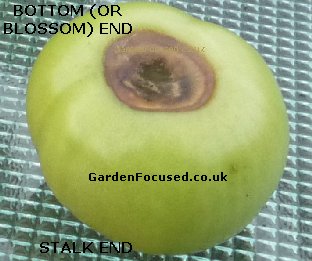The picture below shows the classic signs of blossom end rot on a single tomato.
The likely symptoms are listed below in the order in which they normally occur:
- If you inspect your tomatoes regularly you will notice a small patch on the bottom of the tomato which looks translucent and a slightly different colour to the rest of the tomato. Even at this early stage there is no way to save the tomato but it will allow you to alter your watering regime sooner rather than later which will stop other tomatoes being affected.
- The mark will enlarge and turn brown or black as the tomato grows.
WHAT CAUSES BLOSSOM END ROT
It is caused by a lack of the nutrient calcium in the fruit itself. It’s important to understand that it is NOT caused by a lack of calcium in the soil, adding calcium rich fertilisers to the soil will not solve the problem.
Calcium is taken up by a tomato plant through its roots and it is then passed up to the stems, foliage and finally the fruits. This transfer of calcium occurs through the water inside the plant structure and it requires a constant supply of water at the roots in order for the transfer to reach all parts of the plant. If watering is uneven, with times where there is not sufficient moisture, the calcium may not reach the fruits which are at the end of the supply chain.
Calcium is essential to healthy production of plant cells and where it is lacking the cells explode in slow motion and die. It is this cell damage which is visible in blossom end rot.
HOW TO CURE BLOSSOM END ROT
Damaged tomatoes cannot be saved so they should be harvested and disposed of. The problem occurs when the fruits are half to three-quarters formed so smaller fruits will be unaffected at this stage of their development.
The cure is simply to ensure an even and constant supply of water at the roots. The compost / soil should be kept moist at all times but not water-logged. With grow-bags and potted plants it may well be necessary to water twice a day in warm weather. Multi-purpose compost used in pots and grow bags in particular should never be allowed to dry out, it can take several days of frequent watering to re-moisten it.

BLOSSOM END ROT IN TOMATOES
By David Marks
Blossom End Rot affects several vegetables although it is most common in tomatoes. The tomatoes start to rot at the bottom (the end furthest from the stalk) leaving a balck or dark mark and the whole area starts to sink inwards.
Affected fruits should not be eaten, they should be disposed of. By altering the frequency and amount of watering new fruits can be grown successfully.